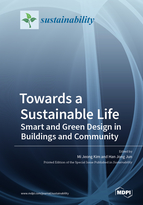Towards a Sustainable Life: Smart and Green Design in Buildings and Community
A special issue of Sustainability (ISSN 2071-1050).
Deadline for manuscript submissions: closed (31 August 2020) | Viewed by 54626
Special Issue Editors
Interests: sensing architecture; design computing and cognition; human-computer interaction
Special Issues, Collections and Topics in MDPI journals
Interests: Affective computing; building information modeling; sensing architecture
Special Issues, Collections and Topics in MDPI journals
Special Issue Information
Dear Colleagues,
Sustainability is a principal value in our environment and lives and does not simply involve sustaining the original environment or reducing the consumption of resources. Sustainable development can also relate to the healthy and smart development of buildings and communities towards a sustainable life. This Special Issue is interested in how sustainable life can be achieved in terms of sustainable architecture and positive technology. Green design is often used interchangeably with environmental sustainability and is mainly considered for sustainable development. However, this Special Issue considers user-centered smart design for sustainable life because our living spaces are integrated with technologies to support people’s activities, and such integration can support sustainable development. Positive technology could improve overall quality of life by promoting occupants’ wellbeing and satisfaction. This Special Issue welcomes research contributions on sustainable life in buildings and communities. The aim is to highlight issues on the sustainable development of our environments and lives by emphasizing smart and green design perspectives. We solicit interdisciplinary articles concerning sustainable life and propose to bring together expertise from environmental psychology, architecture, engineering, social sciences, and technologies to share their approaches to sustainable life. The following are some example keywords, but submissions are not limited to these.
Prof. Dr. Mi Jeong Kim
Prof. Dr. Han Jong Jun
Guest Editors
Manuscript Submission Information
Manuscripts should be submitted online at www.mdpi.com by registering and logging in to this website. Once you are registered, click here to go to the submission form. Manuscripts can be submitted until the deadline. All submissions that pass pre-check are peer-reviewed. Accepted papers will be published continuously in the journal (as soon as accepted) and will be listed together on the special issue website. Research articles, review articles as well as short communications are invited. For planned papers, a title and short abstract (about 100 words) can be sent to the Editorial Office for announcement on this website.
Submitted manuscripts should not have been published previously, nor be under consideration for publication elsewhere (except conference proceedings papers). All manuscripts are thoroughly refereed through a single-blind peer-review process. A guide for authors and other relevant information for submission of manuscripts is available on the Instructions for Authors page. Sustainability is an international peer-reviewed open access semimonthly journal published by MDPI.
Please visit the Instructions for Authors page before submitting a manuscript. The Article Processing Charge (APC) for publication in this open access journal is 2400 CHF (Swiss Francs). Submitted papers should be well formatted and use good English. Authors may use MDPI's English editing service prior to publication or during author revisions.
Keywords
- Environmental sustainability
- Sustainable development
- Sustainable architecture
- Sustainable life
- Smart and green design
- Positive technology
- Buildings and sustainability
- Community and sustainability






